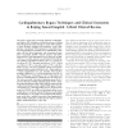Hyperoxia management during deep hypothermia for cerebral protection in circulatory arrest rabbit model.
Parole chiave
Astratto
As a brain protection strategy, antegrade selective cerebral perfusion (ASCP) is widely used in thoracic aorta surgery with deep hypothermic circulatory arrest (DHCA), yet the oxygen management for ASCP has never been standardized. The aim of this study was to investigate the possible neuroprotective effects of hyperoxia management during deep hyperthermia for ASCP combined with DHCA in a rabbit model. Rabbits were assigned into four groups: sham group, without cardiopulmonary bypass (CPB); DHCA group, DHCA for 80 minutes; ASCP group, ASCP combined with DHCA; and SH group, hyperoxia management combined with ASCP and DHCA. Hyperoxia management was performed when the nasopharyngeal temperature was below 22°C. Deep hypothermic circulatory arrest was initiated when nasopharyngeal temperature reached 16-18°C. Blood samples were withdrawn to determine blood gas indexes and neurobiochemical markers of damage, and brain tissues were stored for biochemical analysis. Cerebral oxygen balance was performed better in the SH group compared with the DHCA group and the ASCP group. Hyperoxia management did not increase lipid peroxidation with lower malondialdehyde levels in the SH group compared with the DHCA group and the ASCP group (p < 0.05). S100 calcium binding protein B in the SH group was lower compared with the DHCA group and the ASCP group (p < 0.05). There was no significant difference of neuron-specific enolase in the SH group compared with the sham group. Hyperoxia management during deep hypothermia provided substantial dissolved oxygen and demonstrated better cerebral protection over normoxia management.




